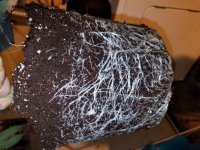Ok can someone explain me big deal with ph run off and coco. I ask this question many times and ask a lot of people. My grow with coco hempy, hand watering once per day. I watering with a lot of run off to keep plants "happy", beleave me I lost a lot of bottles with nutes to keep my run off same like my rez ph and ppm. Results plants grow with deficiency, yield is crap and quality isn't there.
Next grow is pure coco without run off. One bottle a&b is enough for whole grow. All plants grow very well without deficiency, yeild is heavy and quality is there. When I test run off ph is close to 4.8-5.0.
Just test run off ph from fresh canna coco bag watering with tap water 8.0 ph comes out 5.2.
Next grow is pure coco without run off. One bottle a&b is enough for whole grow. All plants grow very well without deficiency, yeild is heavy and quality is there. When I test run off ph is close to 4.8-5.0.
Just test run off ph from fresh canna coco bag watering with tap water 8.0 ph comes out 5.2.




